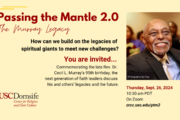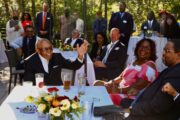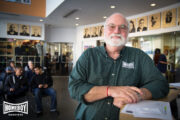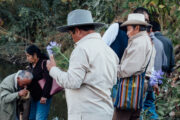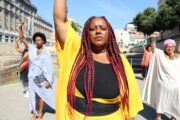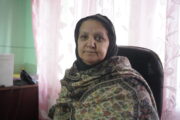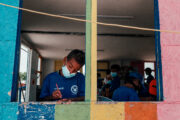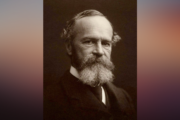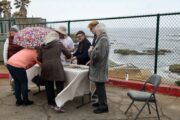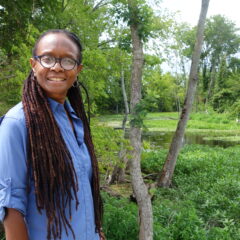The Spiritual Exemplars Project (SEP), funded by a grant from the Templeton Religion Trust, has spent the last two years collecting stories of individuals who are inspired by their faith or spiritual values to do extraordinary good in the world. SEP’s team of two-dozen journalists and social scientists has collected stories from exemplars around the world like Dr. Tom Catena, who left everything behind to direct the only hospital in a war zone in South Sudan. And Julie Coyne, who left her home in Connecticut to work with some of the poorest communities in highland Guatemala. Thirty years later, Coyne is still there, as is Dr. Catena—who married a local nurse.

As we reach the midpoint in the project, we have begun to reflect on the lessons that have emerged from our work in the field—what can we learn from the lives of these world-changers?
Defining and Studying Spiritual Exemplars
Two years ago, the Center for Religion and Civic Culture at University of Southern California launched a global project to study spiritual exemplars: people who are advancing human development, grounded in faith traditions or spiritual practices that enable them to work on the most difficult issues in some of the most challenging contexts in the world. While prior studies have shown that spirituality is a driving force for many of today’s world-changers, we wanted to better understand how that phenomenon works.
We developed analytical criteria that focus on living exemplars who are motivated by their faith or spirituality to lead humanitarian efforts that promote human flourishing, often inspiring emulation beyond their communities. Our criteria excluded religious leaders with regressive values, political leaders using faith to promote violence or hate, and ascetics who ponder the nature of God or the universe without active involvement in the world.
Our team created a database of more than 300 potential exemplars representing dozens of countries and all the major religious traditions. The exemplars’ work focuses on a spectrum of issues such as hunger, health, climate change, human rights and education. In addition to studying existing literature about the lives and work of spiritual exemplars, we deployed a team of journalists and social scientists to conduct interviews and produce articles, podcasts and short documentary films with the hope of contributing to a public conversation about the role of religion in contemporary society.
Despite the onset of a global pandemic less than a year into our research, our team has so far profiled over 55 spiritual exemplars and produced work in about 90 different publications. These exemplars represent 12 different faith traditions and work in 31 countries around the world. Simultaneously, the research team is coding interview transcripts and doing a deep dive into trends and theoretical questions arising from the data.
Engaged Spirituality: Where We Began
In the early stages of the project, we posited that we would see religion and spirituality playing a number of different roles for people who are engaged in humanitarian projects. We also guessed that the relationship would flow in both directions–that the difficult work that exemplars undertake would lead them to evolve in their theological and spiritual understanding over time. Initially, four key issues stood out for us:
First, we surmised that religion and spirituality would provide Inspiration, offering exemplars encouragement, community and the ability to reimagine solutions. We assumed that religion and spiritual practice might lead some exemplars to radically shift their self-conception, allowing them to reject societal norms and “march to a different drumbeat.”
We also felt that spirituality and belief might act as a Source of Sustenance, providing the means to persevere during major challenges. Spirituality and religious practice would provide not only vision but also the daily renewal that might allow individuals to persist against great odds. We projected that the faith dimension of spiritual practice may also allow exemplars to reframe difficult experiences and personal struggles as redemptive, allowing them to continue work in the toughest of circumstances.
We argued further that spirituality and faith systems may provide a context for Learning and Growing. Personal liberation and radical joy might come for exemplars in the very difficulty of the suffering. We guessed that through their work exemplars might lose their attachment to material outcomes and traditional measures of success and instead experience a form of inclusive love that diminishes the boundaries between “us and them.”
Finally, we assumed that some spiritual exemplars might exhibit a Shadow Side. This project strives to understand exemplars in all their complexity, and therefore explores the “demons” with which exemplars wrestle. The stories of exemplars include broken relationships, traumatic experiences, deep doubts and even vices and poor habits of self-care. We predicted that, given the chance, exemplars might be honest about the difficult choices they have had to make and about how their work and faith practice can improve.
Emerging Insights from the Field
At the halfway point of our data collection, we are seeing a number of interesting themes emerge that affirm, challenge and refine the ideas with which we began. In obvious ways, exemplars as well as their social contexts are often atypical and extreme. One justification for studying exceptional cases is that they inspire emulation. Extraordinary individuals are important for another reason: They exhibit certain core qualities in stark relief, making visible what goes unnoticed under more mundane circumstances. In this regard, what we have seen so far greatly intrigues us, and raises as many questions as it answers.
For example, why do spiritual exemplars seem to exhibit qualities of extreme grit and tenacity and, simultaneously, radical surrender to a divine source? How is it that they seem to feel the pain and despair of others so deeply in ways that bystanders do not, and yet at the same time often embody qualities of tranquility, persistent optimism and joy?
While we are too early in our process to explain relationships in what we are seeing, we can highlight a few emergent themes for further reflection.
First, as expected, we find that for most of our sample, spirituality is a deep force that motivates, compels and sustains exemplars in their engagement with the world. They may be Buddhist, Muslim, Christian or not adhere to any particular tradition, but what they do share is an engaged understanding of the divine that is not remote from daily human life.
In fact, most exemplars shun forms of spirituality that are separate from the present reality and from the suffering to which the exemplars are responding. Swami Agnivesh, interviewed in India by SEP journalist fellow Soumya Shankar not long before Agnivesh’s death, embodied this perspective, saying, “Don’t bother about what happens once you die. You have to do in this world what you must. If you consider yourself spiritually evolved and are committed to justice, to the poorest of the poor, you’re on the right path.”

What also emerged early in our study is that shadows and deep struggles are not peripheral to the lives of exemplars; rather, they are central. Exemplary individuals do not fall out of the sky as agents of social transformation. They often endure years of deep struggle and wrestle with their own sets of demons. Some have experienced personal traumas and arrived at a redemptive narrative of their experiences over time.
Exemplars also do not avoid difficulty—in fact, many continuously insert themselves in difficult contexts. As Fr. Jacques Mourad of Iraq put it when interviewed by SEP journalist fellow Stephanie Saldaña, “Today we are standing in front of the virus of violence, which is penetrating every place and every person and every society. The cure is not by running away. The cure is rather through solidarity, and a deep spiritual awareness.”

For many exemplars, the path toward the Sacred is most clearly visible where oppression is rife and all material comforts are stripped away.
While exemplars often approach their work with a particular theology or set of guiding beliefs, theology isn’t just the input, it is also an output. Put differently, the process is dialectic: In the act of working in the hardest of contexts, exemplars themselves are transformed; their theology and understanding of the Divine is changed; their sense of mission is challenged and reshaped.
Sister Marie-Stella Kouak, the founder of a groundbreaking HIV/AIDS health center in Togo, describes this adaptability in an interview with SEP journalist fellow Clement Giradot: “As a woman of faith, I cannot give in to discouragement. This is the time to invent new ways to continue our mission.”
And Ida Puliwa–a young Malawian exemplar who created an NGO called Othakarhaka (Passing on Kindness)–in an interview with Don Miller describes how, when she confronts problems, she sometimes feels God is absent, but then realizes that maybe God is allowing a problem to make her stronger or push her forward. “I know God is here. . . He’s always there to watch us. He never sleeps, he never slumbers.”
Many exemplars from a very young age seem to have “a gift” or experience “a calling” to engage in humanitarian work. They feel the pain of others in a different way, in their very bodies, and they are compelled to act in response to that pain.
As Heline Babiene Eweni described, when interviewed by SEP journalist fellow Innocent Eteng, “I didn’t want to see another child in a situation of need. . . . I was the only person who knew what we were going through. When I see a young person in need, it affects me; it disturbs me psychologically.”
Edmund Kaszibuloh Koroma, a Sierra Leonean hero credited with saving thousands of child soldiers, also interviewed by Innocent Eteng, recalls that one night, many years ago, he had a dream in which “I saw Jesus walking down and He said to me, ‘I bless you!’” Since then, Koroma has committed himself to protecting children: “[The dream] guides me,” he said. “It is in my mind every time.”

And Jean Gakwandi, a survivor of the Rwanda Genocide, recalls that he felt a clear call from God telling him to “Comfort my people.” Despite his own grief, Gakwandi felt compelled in that moment to take up the task of comforting his fellow survivors, particularly widows and orphans, the most destitute and the most devalued in his society.
It is not only that the exemplars in our sample feel spiritually called to act while bystanders turn away. They also have extreme staying power. Prior research, such as Damon and Colby’s classic study, seeks to understand why “some do care.” Our project has shown that many “do care,” but beyond care, another intriguing quality of exemplars in our sample is that they have what appears to be a superhuman form of grit.
We find that exemplars’ ability to persevere is grounded in and nurtured by their spiritual practices and rituals, which in turn renew, affirm and broaden their faith and vision. Spiritual exemplars engage in a number of practices such as meditation, prayer, retreats and rituals, along with deep listening and mindfulness in their interactions with the people they serve.
Moreover, the exemplars in the study thus far, across almost all faith traditions, describe experiences of deep surrender. As Sr. Rosemary Nyirumbe, a CNN Hero awarded for her work in Uganda, said in an interview with Don Miller: “This has been my journey–complete trust that I will be taken care of by God, complete trust that I will lack nothing, complete trust that I don’t need to surround myself with many things.”

This act of surrender also lends itself to stress release and relaxation. Tuenjai Deetes, an exemplar from Thailand who has worked with stateless populations, describes her spiritual practices in an interview with SEP journalist fellow Magdalena Rojo, saying: “I may be tired and work too much, but with mindfulness meditation I feel like I can relax in the middle of the work.”
The act of surrender also allows exemplars to take risks. As Sister Pat Murphy and Sister Joann Persch explained in interviews with SEP journalist fellow Heidi Shin, it is their faith and practice that teaches them to work around obstacles in their work on behalf of those in detention centers in Illinois. Two of their favorite mottos are “never take no for an answer” and “if you can’t get in the front door, go around the back.”
Ashin Issariya, a consecrated Buddhist priest from Myanmar, describes this faith-based imperative to act when interviewed by SEP journalist fellow, Krithika Varagur: “I tried to see changes in this country, so I risked my life,” he said. “I was not afraid to tell someone that they were wrong.”
At the start of our project, we wondered whether our exemplars would spend much of their interview philosophizing about God, but they rarely do. Instead, the question that arises is “Where is God?” or “Where does the sacred reside?”
For almost all the exemplars interviewed, God, Spirit or the Divine lives in the very communities they serve. When Padre Ismael “Melo” Moreno of Honduras, interviewed by SEP journalist fellow Maria Martin, says he “can’t feel God,” he goes to the mountain and grinds coffee with impoverished farmers. It is in this form of retreat that he feels the Spirit is alive and well.
For many exemplars in our sample, the Spirit is what binds us to one another. It is what exists within and between us. It is what connects us. It is what gives us equal value in the face of differing circumstances. That Spirit—the Sacredness within—according to exemplars in our sample, is inextinguishable. In the context of deep suffering, when all else is stripped away, something sacred shines through, illuminating our common humanity.
As SEP continues to collect the stories of exemplars around the world, with the aim of completing our sample of 100, we expect these insights to grow, change and build upon one another towards a fuller understanding of the pro-social role of religion.
Arpi Miller is an affiliated scholar with the USC Center for Religion and Civic Culture.
Hebah Farrag was the assistant director of research of the USC Center for Religion and Civic Culture through 2023.


